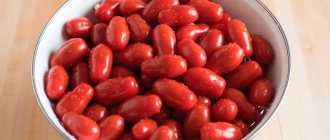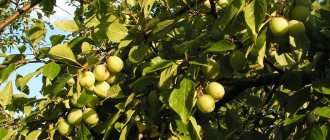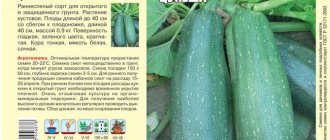Eggplant Valentina F1 is a productive early-ripening hybrid of Dutch selection. Our gardeners are attracted by its tasty fruits and low maintenance requirements. We will learn about all the features of this variety, how to grow it on your plot and how to achieve high yields.
Eggplant Valentine has no bitterness
Eggplant Valentine
Valentina eggplants store well
Hybrid characteristics
The hybrid “Valentina” was bred by the Dutch company MONSANTO HOLLAND BV and was included in the Russian State Register in 2007. Suitable for growing in personal plots - in open and closed ground.
Description of the plant
Bushes of the Valentina variety can be classified as medium-sized or tall-growing eggplants. The plants have a powerful, straight stem and large flowers.
Description of eggplant bushes Valentina F1:
- semi-spreading;
- height – 80-90 cm;
- hairy, light purple stems;
- medium-sized leaves, notched along the edges;
- the flowers are white-violet, 3-4 cm in diameter.
Fruit
The fruits of the Valentina F1 eggplant have a traditional appearance for this crop.
Fruit characteristics:
- shape – teardrop-shaped, elongated;
- length of the ripe fruit – 20-26 cm;
- thickened, the lower part of the fruit reaches a diameter of 5 cm, the upper – 4 cm;
- average fruit weight – 200-250 g;
- the skin is thin, shiny, easy to clean;
- the pulp is creamy white, with small seeds;
- The taste of the pulp is pleasant, without bitterness.
Productivity and fruiting
Eggplant Valentina F1 is an early ripening variety. The fruits ripen 60-75 days after planting the seedlings. The first eggplants, in temperate climates, are picked in July. Maximum fruit weight – 300 g.
Productivity of eggplant Valentina F1:
- in open ground - 2.8-3 kg per 1 sq. m;
- in greenhouse conditions - up to 5 kg per 1 sq. m.
Area of use
Fruits picked in the technical ripeness phase are used:
- In cooking. They are boiled, fried, stewed, baked.
- For blanks. Eggplants are prepared in different ways - they are dried, frozen, canned, pickled.
Resistance to diseases and pests
This Dutch variety has high immunity, but under unfavorable growing conditions it can be affected by pests and diseases. At high humidity, the hybrid is affected by fungi, but is resistant to tobacco mosaic.
The variety can be attacked by pests:
- aphid;
- Colorado potato beetles;
- spider mite;
- slugs
Reviews from gardeners
On the Internet you can find a lot of positive reviews confirming the productivity and unique taste of this eggplant variety. As many housewives claim, these eggplants are perfect for canning. They are not bitter at all, cook quickly and have practically no seeds inside. What is important is that this variety takes root well in greenhouse conditions and is resistant to any viruses.
Among the negative reviews, one can highlight the fact that if seeds are stored for a long time and incorrectly, the germination rate will be low.
Attention! Eggplant Valentina f1 is not susceptible to infection by the tobacco mosaic virus, which infects plants and interferes with the normal development of the fetus.
Thus, the “Valentina f1” eggplant can be safely called one of the most unpretentious vegetables that any amateur gardener can grow. But keep in mind that this vegetable really does not like low temperatures and excessive watering.
Advantages and disadvantages of eggplant Valentine
The Dutch hybrid has many advantages, for which our gardeners grow it.
Pros:
- Adaptability to different weather conditions. The hybrid withstands adverse external influences without reacting to cold or heat by dropping buds and flowers.
- High yield.
- Undemanding to growing conditions.
- Due to the small number of seeds, the fruits have a delicate structure.
- The fruits are the same size.
- Good transportability.
- High safety. Fruits placed in a dry and cool room can last for a whole month without significant loss of presentation and taste.
The variety has no obvious disadvantages. Some gardeners may not like:
- Fruit shape. Eggplants grow quite thin, and many people like pear-shaped eggplants, with a large thickening of the lower part.
- Taste of fruits. Not all gardeners are satisfied with the taste of the hybrid. Also, “Valentina” is not liked by those who prefer fruits with large seeds.
Description of the plant
Bushes of the Valentina variety are erect, vigorous, semi-spreading, rising to 0.8-0.9 m. The trunk of the plant is pubescent, distinguished by a faint light purple color. Medium-sized leaves of a rich green hue, notched along the edges. The flowers are large, white and purple.
Dark purple fruits are elongated, drop-shaped, can stretch up to 20-26 cm. The diameter of the thickened, lower part of the fruit is up to 5 cm, the upper part is up to 4 cm. The weight of the fruit reaches 200-250 g. The skin is glossy, thin, easy to peel . The dense flesh has a pleasant creamy white color. Descriptions of gardeners who grew this hybrid note a soft and delicate taste of the fruit, without a hint of bitterness.
Features of planting and growing the variety
It is recommended to grow eggplants using the seedling method. It allows you to get strong, viable plants and an early harvest - the first fruits are harvested in mid-summer.
Soil preparation
It is best to grow eggplant seedlings in a special soil mixture - it is sold in agro-shops. If desired, you can prepare the soil yourself.
To prepare the soil for seedlings, mix in equal parts:
- compost or humus;
- peat;
- sand;
- fine sawdust or perlite.
Add ash to the thoroughly mixed mixture - 1 cup per bucket, or saltpeter - 10 g. The soil is also enriched with urea - 1 tbsp is dissolved in 10 liters. l. fertilizers
Timing
The exact time to plant seeds depends on the growing region. When choosing a sowing date, take into account the time of planting and the duration of growing seedlings. From the moment of sowing to readiness, it takes about 2 months.
In regions with a temperate climate, sowing seeds for growing eggplant seedlings is carried out from the second half of February to mid-March.
Sowing seeds without germination
It is not necessary to germinate eggplant seeds. But they can be disinfected in hydrogen peroxide or a growth stimulant.
Eggplant seedlings are grown in separate containers. They do without picking, since the seedlings have a very delicate root system, and replanting harms them. Therefore, seeds are sown immediately in pots or cassettes, and not in large containers.
Seed sowing order:
- Fill the pots with the prepared mixture or purchased soil mixture. Do not compact the soil.
- Make small indentations in the center of the pot. Plant the seeds to a depth of 1-1.5 cm.
- Place only one seed in one hole.
- Water the crops and cover with soil.
- Cover the pots or cassettes with transparent material and place them in a warm, well-lit room.
- Maintain the temperature during the day at +26 to +28 °C, and at night at +15 to +16 °C.
Eggplant variety Valentina from seeds
Eggplant Valentina is most often grown by seedlings. Fruits collected with one's own hands are not used for this purpose, since new hybrid plants do not repeat the quality of the mother plant during further reproduction.
Rules for sowing seeds
Dutch hybrid seed material can be purchased in specialized stores for gardeners. Most often, it is already pre-treated and completely ready for planting in the ground.
Otherwise, the seeds need to be prepared using one of the following methods:
- Soak the seeds in a weak solution of potassium permanganate (1%) for 15-20 minutes. Then leave for 8-12 hours in a growth stimulator (Energen with water in equal parts).
- Pour 4-6 drops of hydrogen peroxide into a glass of water heated to 40°. Pour this mixture over the eggplant seeds for 15 minutes.
- Dilute 1 g of boric acid in a glass of water warmed to room temperature, pour over the seeds for 20-30 minutes.
Prepared seeds are sown in plastic containers or peat pots with substrate. To prepare it, you can mix peat, turf soil, ash, humus and sawdust, taken in equal proportions. In clay soil you need to add a little coarse sand.
Pour heated water over the substrate and lay out the eggplant seeds, deepen them by about 1 cm and cover with plastic wrap. After 8-10 days, shoots begin to appear - after which the film can be removed.
Landing place
Sowing Valentina eggplants for seedlings is best done in the first weeks of March. This makes it possible to transplant young plants to a permanent place in the second half of May or early June.
For planting, it is best to choose a well-lit, warm place, since with a lack of light, eggplant seedlings begin to weaken and become pale. In early spring, installing additional phytolamps will help solve the lighting problem.
Watering
The soil in a peat pot or container should be moderately moist. Lack of moisture, as well as its excess, are detrimental to the plant. For irrigation, only settled water at room temperature is used. You need to irrigate eggplants very carefully so that their roots are not exposed and the seeds are not washed out.
Seedling care
Eggplant crops require daily care - it is necessary to maintain air temperature, soil moisture, feed the grown seedlings in a timely manner, and ensure the correct lighting conditions.
Temperature
When growing any seedlings, including eggplant, the ambient temperature changes depending on age.
Features of temperature conditions:
- For 14-15 days after sowing, maintain the temperature at +26 ... +28 °C.
- When shoots appear, the film or glass is removed, the pots with seedlings are placed closer to the light, and the temperature is reduced to +23...+25 °C. This limitation helps to avoid stretching of seedlings.
- Night temperatures should be +15…+16 °C.
- On cloudy days, it is recommended to lower the daytime temperature by 2–3 °C.
Daylight hours
Seedlings need long daylight hours. If there is not enough sun, additional artificial lighting is used.
Features of the light mode:
- For lighting, it is advisable to install special phytolamps with a red-blue light spectrum, which is favorable for plants. With such lamps, seedlings can be grown even in dimly lit rooms.
- Daylight hours should be 10 hours.
Watering
Seedlings need regular moisture. The main principle of irrigating seedlings is regularity, which should take into account the condition of the soil.
Watering rules:
- water for irrigation should be heated to +20 °C;
- the soil is moistened as it dries, the average frequency of watering is once every 2 days;
- An excess of moisture is not allowed - the seedlings may get blackleg.
During watering, it is recommended to use antifungal drugs - “Fundazol” or “Gauspin”.
Top dressing
If seedlings are grown in fertile, well-fertilized soil mixture, then you can do without fertilizing. Otherwise, the seedlings will have to be fed.
How to feed seedlings:
- Water with Kristalina solution 2-3 times. To prepare the solution, dilute 6-8 g of the drug in 10 liters of water.
- Dilute 30 g of superphosphate and 10 g of urea in a bucket of water, and pour the prepared solution over the seedlings.
Transplanting seedlings
2 weeks before planting seedlings in open ground, the seedlings begin to harden and are taken outside. First for 20 minutes, then every day the duration of the “walks” is increased, gradually reaching several hours.
Hardening is necessary for plants to improve adaptation to new conditions - sunlight and sudden temperature changes.
Seedlings ready for transplanting must have at least 5 true leaves. The height of the seedlings is 20-25 cm. Another sign of seedling readiness is the appearance of buds.
The procedure for transplanting seedlings into the ground:
- Prepare the landing site. This should be a well-lit area in which legumes or melons grew. Dig it up and fertilize it with superphosphate (30-50 g per 1 sq. m), wood ash (1 cup per 1 sq. m) and potassium sulfate (15-20 g per 1 sq. m).
- Dig holes for seedlings at intervals of 25-30 cm. If the soil is clayey, add a handful of sand to the holes. There should be a distance of 60-70 cm between adjacent rows. The depth of the holes is 15 cm.
- Before planting, water the holes with water - approximately 500 ml per hole.
- Place the seedling in the hole. Deepen it to the cotyledon leaves, sprinkle with soil and lightly compact it.
- Water the plants again and mulch with dry grass or pine needles. Instead of natural mulch, you can use dark film - it is laid between the rows.
It is recommended to transplant eggplants into open ground in the evening in calm weather.
In order not to provoke excessive growth of green mass, it is necessary to follow the dosage when feeding eggplants with mullein infusion. No more than 500 ml of solution is poured under one bush (200 ml of mullein infusion is diluted in 10 liters of water).
Growing in a greenhouse
In regions with cool summers, eggplants are planted not in open ground, but in unheated greenhouses or film shelters.
Features of growing eggplants in a greenhouse:
- “Valentina” eggplants are planted in greenhouses from approximately May 10 to May 20.
- The planting pattern is similar to open ground - 60x30 cm.
- The bushes are watered only with warm water 2 to 4 times a week.
- After watering, the soil must be loosened, trying not to damage the roots.
- It is recommended to mulch the soil.
- 3 weeks after planting, the plants are fed. The best option is to water the plantings with Kemira Universal solution. The solution is prepared by diluting 1 tbsp. l. drug in 10 liters of water. Watering rate is 500 ml per plant.
- Organic or mineral fertilizers are used for feeding. Recommended organics are wood ash, fermented solution of grass and weeds, diluted manure.
- When the ovaries appear, half are removed, leaving the largest ones. This will speed up the ripening of the fruits and make them larger.
- The greenhouse is regularly ventilated so that the eggplants do not “suffocate”. The "Valentina" variety is very resistant; it can withstand unfavorable conditions, including elevated temperatures. The bushes will retain the ovaries, but the fruits will grow small.
- In the greenhouse it is necessary to maintain optimal humidity - no more than 70%. If the greenhouse is damp, the pollen from the flowers will not be able to move in space, and the yield will drop.
History of selection
Cabbage Valentina F1 - a productive hybrid variety of domestic selection
Valentina F1 is a hybrid form of cabbage obtained from white cabbage. The variety was bred at the Moscow Breeding Station named after. N. N. Timofeeva. The authorship belongs to the breeders A.V. Kryuchkov, G.F. Monakhos and D.V. Patsuriya. In 2004, Valentina F1 was included in the State Register and zoned into the Ural, North Caucasus, Far Eastern, Central Black Earth, East Siberian, Northern, West Siberian, Central, Volga-Vyatka and West Siberian regions.
Caring for eggplants in open ground
Hybrid "Valentina" is unpretentious and requires only standard care. It is important to provide the culture with the minimum necessary growing conditions - warmth, water, nutrition.
Eggplants are grown in open ground only in regions with warm summers - in the south of Russia. In the middle zone, it is recommended to plant them in greenhouses or under film covers.
The optimal temperature for the growth and development of eggplants is from +28 to +30 °C. At lower temperatures, the culture lags behind in development.
Watering and fertilizing
Watering eggplant is a necessary agrotechnical measure, on which the development of the plant and its productivity directly depend.
Watering rules:
- The first time planted eggplants are watered no earlier than 5 days after planting.
- Water the eggplants at the root.
- The best time to water is morning.
- Water temperature from +26 to +28 °C.
- The frequency of watering in open ground is 2-4 times a week.
Fertilizing is combined with watering so as not to burn the roots of the plants.
Feeding scheme:
- 2-3 weeks after transplanting into open ground, eggplants are fed with “Kemira” or “Solution”. Dilute 1 tbsp in a bucket of water. l. fertilizers The feeding rate per bush is 500 ml. You can also use any organic matter.
- At the budding stage, phosphorus and potassium are added. Dilute 1 tbsp in a bucket of warm water. l. potassium sulfate and 1.5 tbsp. l. ammonium nitrate.
- During the formation of ovaries, a nitrogen-phosphorus “cocktail” is added. 25 g of superphosphate and potassium salt are dissolved in 10 liters of water. It wouldn’t hurt to add wood ash - 1 cup per 1 square meter. m.
- A month before harvesting, plants are given dissolved superphosphate and potassium salt - 1 tbsp is diluted in a bucket of water. l. each component.
Soil care
After each watering, the soil must be carefully loosened. Eggplants have roots quite close to the surface, so loosening must be done extremely carefully.
After loosening, the soil is mulched - with humus, dry grass or other suitable material.
Bush formation
Eggplant Valentina F1 is distinguished by tall and rather spreading plants. But they do not need special pruning; minimal measures are enough.
Recommended:
- Tie the bushes to supports - pegs.
- Carry out sanitary pruning - pick off dried leaves and shoots.
Prevention of diseases and pests
Hybrid "Valentina" is resistant to viruses, but can be affected by fungal diseases.
Recommended for prevention purposes:
- Treatment with Fitosporin or Zircon to prevent fungal damage.
- Spraying wood ash on the ground will repel slugs.
Between the beds it is recommended to plant plants with a strong smell - for example, calendula or marigolds.
Diseases and pests
Under unfavorable growing conditions and lack of prevention, even a resistant hybrid can be affected by diseases (viral and bacterial) and pests.
Possible diseases of the Valentina hybrid:
- Late blight. Accompanied by the appearance of brown spots on the leaves. Over time, the spots spread to shoots and fruits. The plant dies. To prevent the disease, eggplants are sprayed with fungicides containing copper - Bordeaux mixture, copper sulfate, copper oxychloride and others.
- Black bacterial spot. Symptoms are the appearance of black spots with a yellow border. The fruits become covered with ulcers. Plants are treated by spraying with Phytoflavin-300.
- Gray rot. Appears at high humidity. The leaves are covered with gray spots. Spraying with Horus helps get rid of the disease.
The most dangerous pests:
- Whitefly. Small butterflies whose larvae suck the juices from the plant. It is recommended to water the roots with Aktara.
- Aphid. Spraying with a solution of ash and laundry soap helps get rid of it. Several treatments are required. In case of mass destruction, use “Iskra”, “Strela”, etc.
- Colorado beetle. Spraying with Corado and Aktara preparations is recommended. You can collect beetles with your hands.
- Spider mite. If there are a small number of pests, the web and damaged parts of the plants are torn off. Spraying with ammonia solution is recommended.
Harvest and storage
The fruits are collected as they ripen. They are picked when they reach technical ripeness, when the skin acquires a dark purple hue. The length of the ripe fruit should reach 20-25 cm.
Recommendations for collection and storage:
- Start collecting fruits at the end of July - as they ripen. Carry out mass cleaning with the onset of cold weather.
- Cut the fruits with pruning shears.
- Store the collected fruits in a cool place. Shelf life – 1 month.
- Do not pick green eggplants - they are inedible, just like overripe ones. Their flesh is bitter and the seeds become rough.
- Pick the fruits every few days, avoiding overripeness. If the skin of the fruit has become dull and faded, it means they are overripe. They must be picked, otherwise the formation of new fruits will slow down.
Valentina cabbage: description from seed producer Gavrish
Late-ripening (140-180 days from germination to technical ripeness) variety
. Sowing seedlings in March. Picking in the cotyledon phase. Planting in the ground in mid-late May according to the 60x40 cm pattern. The rosette of leaves is raised. The leaf is medium-sized, gray-green with a strong waxy coating, slightly wavy along the edge.
The head of cabbage is medium in size, obovate in shape, very dense, white when cut. The variety is valued for its high yield, excellent marketability and taste. Productivity 6.8-8.0 kg/m2.
Manufacturers: Prestige, Search, Gavrish, Aelita, Sedek, Euro-seeds, Semko, Plasma seeds and many others.
Recently also searched:
Advice from experienced vegetable growers
There is nothing complicated in growing Valentine F1 eggplants, but there are secrets that will help you get a rich harvest while avoiding losses.
Advice from experienced gardeners:
- After transplanting seedlings into a greenhouse, do not rush to water it. Let 5-6 days pass.
- When watering, pour at least 500-1000 ml of water under one bush.
- Water the plants only with warm water. Pour water under the root, the water should not get on the leaves.
- Sprinkle ash scattered on the soil with water - pests cannot stand the smell of wet ash.
- Eggplants get along well with short greens - dill, sorrel and garlic. But proximity to tomatoes is unacceptable. Both crops - eggplants and tomatoes - belong to the nightshade family, and their proximity harms each other. They suffer from the same diseases and have the same insect enemies.
Description of Valentina
This is a late-ripening hybrid. From the moment of germination to harvest, it can take from 150 to 180 days.
The leaf rosette of cabbage is of a raised type. The leaves are relatively small, gray-green in color. Abundantly covered with a waxy coating. The edge of the leaf shows slight signs of waviness.
The head of cabbage is dense, with an average weight of up to 4 kg. In cross-section, the “head” is white. The inner stump is small, the outer one is slightly larger.
High-yielding hybrid. From 1 hectare of plantings you can collect 68-80 tons of products (maximum 100 tons). Of the harvested crop, approximately 90% is ideal for sale on the market.
Valentina is one of those varieties that are recommended for consumption after long-term storage. The heads of cabbage themselves are very juicy and sweet and yet do not spoil even until June.
The hybrid is universal in all respects:
- Suitable for fresh consumption.
- Suitable for fresh consumption after long-term storage.
- Suitable for making borscht, cabbage pies, etc.
- Suitable for fermentation.
In addition, it is worth noting the high resistance to cracking of heads of cabbage, protection from Fusarium wilt and gray rot. Also, thanks to the relatively low external stump, the plant does not fall on its side when a large “head” is formed.
Reviews from gardeners
★★★★★
Raisa, 40 years old, summer resident, Belgorod region. I have been growing the “Valentina” variety for 3 years.
It has shown itself to be early ripening and productive; in mid-July I begin to pick the first fruits. The taste is pleasant, in no way inferior to the best varieties. The only negative is the thin fruits. ★★★★★
Oleg, 50 years old, gardener, Moscow region. I grow the “Valentina” variety in a polycarbonate greenhouse.
The bushes are tall and have to be tied up. The hybrid is undemanding, grows quickly and is always productive. The downside is that you have to buy seeds every year. Hide
Add your review
The Dutch hybrid "Valentina" performs well in our latitudes. This variety successfully combines unpretentiousness with high yield. By providing the culture with minimal care, you can get 3-5 kg of high-quality and tasty eggplants from every square meter.
0
0
Copy link
Cabbage "Valentina F1" variety description
To harvest cabbage early, this variety is not suitable for you at all. The variety is late in ripeness, 120 - 180 days until full ripening (data differs from different manufacturers). You can speed up the ripening process by planting cabbage in seedlings. This method is used by gardeners in the northern and central cities of the country.
Photo of cabbage variety Valentina
During ripening, a dense medium-sized fork is formed, with a fruit weight of up to 4 kg
. The fork is round, light inside, with a short white stalk. The leaves of Valentina cabbage are medium in size, slightly wavy at the edges. There is a thin layer of wax on the surface of the upper leaves.
Valentina cabbage leaves are very juicy, crispy, tasty, sweet, bitterness is almost not felt. It contains many vitamins, which makes cabbage not only tasty, but also healthy. When stored, the taste of cabbage only improves.
Video about cabbage Valentina
The Valentina variety gives a large harvest; about 8-12 kg of cabbage can be harvested per square meter
, depending on the size. The root system of this variety is compact, which allows for dense planting. Per sq. you can plant three sprouts per meter.
Valentina cabbage stores well all winter
, and if special requirements are met, the shelf life can be extended by a couple of months. Can also be stored ready-made.
On a note!
The Valentina variety is perfect for fermentation. Even after processing, the vegetable retains its taste, freshness and wonderful smell.
Cabbage does not crack, thereby retaining its presentation
. The forks can easily withstand long-term transportation. These properties make the Valentina cabbage variety an excellent option for trading activities.











